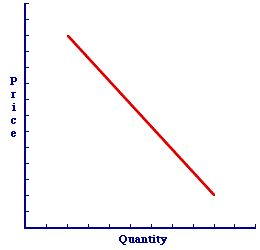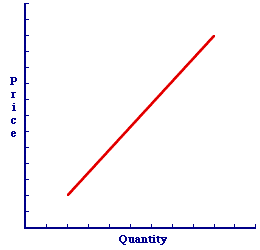
|
|
BETTER BUSINESS BUREAU: A group of businesses and organizations in a local community that seek to eliminate unethical business practices and protect consumers. The first Better Business Bureau was established in 1912 in Minnesota. Today, most local communities (read this as cities) throughout North America have Better Business Bureaus. This private response to questionable business practices should be compare with the government response, the Federal Trade Commission.
Visit the GLOSS*arama
|
|


|

|
                           COMPLEMENT GOOD: In general, one of two (or more) goods that are related in a joint manner. In terms of demand, complement goods are those that provide satisfaction of a want or need when consumed together. In terms of supply, complement goods are those that are simultaneously produced using a given resource. A complement good is one of two ways that goods are related. The other is a substitute good. Goods can be complements in terms of consumption or production.- Complements-in-Consumption: Two or more goods that satisfy the wants or needs when consumed jointly. Satisfaction is greater when both goods are consumed together than when they are consumed separately.
- Complements-in-Production: Two or more goods that are jointly produced using a given resource. The production of one good automatically triggers the production of another, often as a bi-product.
On the Consumption SideComplements-in-consumption are goods that provide greater satisfaction when consumed together. Buying and consuming either good by itself is not quite as satisfying as both goods combined. In many cases, if both complement goods cannot be consumed, then neither will be purchased. Buy both, or buy neither.The need for food can be satisfied by consuming a hamburger and french fries. The need for transportation can be satisfied by buying a sport utility vehicle and gasoline. The desire to play golf can be satisfied by purchasing golf clubs and golf balls. Satisfaction is less if only one of each pair is consumed. The price of a complement-in-consumption is part of the other prices demand determinant. A change in the price of a complement-in-consumption causes a change in demand and a shift of the demand curve. An increase in the price of one complement good causes a decrease in demand for the other. A decrease in the price of one complement good causes an increase in demand for the other. To illustrate this process consider two tasty complement food products--Super Deluxe TexMex Gargantuan Tacos and OmniCola soft drink. While each is enjoyable in its own right, when consumed together they create a satisfying meal. Complement-in-Consumption
OmniCola | 
|
How is the demand for OmniCola affected if the price of Super Deluxe TexMex Gargantuan Tacos should change?- A Higher Price: Suppose the price of Super Deluxe TexMex Gargantuan Tacos increases. Lunch-seeking consumers making a food selection decision will undoubtedly react according to the law of demand and decrease the quantity demanded of Super Deluxe TexMex Gargantuan Tacos. However, when they purchase fewer Super Deluxe TexMex Gargantuan Tacos, then are also inclined to want or need less OmniCola. The result is a decrease in the demand for OmniCola and a leftward shift of the demand curve. Click the [Price Increase] button to demonstrate.
- A Lower Price: Suppose the price of Super Deluxe TexMex Gargantuan Tacos decreases. Lunch-seeking consumers will also react according to the law of demand, but in this case they increase the quantity demanded of Super Deluxe TexMex Gargantuan Tacos. And as they purchase more Super Deluxe TexMex Gargantuan Tacos, then are also inclined to want or need more OmniCola. The result is an increase in the demand for OmniCola and a rightward shift of the demand curve. Click the [Price Decrease] button to demonstrate.
On the Production SideComplements-in-production result when the production of one good triggers the production of a secondary good, or bi-product. Both goods are simultaneously produced from the same resource. The production of one good does not exclude the production of the other. In fact, it promotes the production of the other. Produce one, produce both.Agricultural producers frequently generate bi-products when they produce a primary good, such as wheat and hay. Cattle ranchers produce both beef and leather from the same cattle resource. Lumber mills use timber resources to the produce two-by-fours and sawdust. The price of a complement-in-production is part of the other prices supply determinant. A change in the price of a complement-in-production causes a change in supply and a shift of the supply curve. An increase in the price of one complement good causes an increase in the supply of the other. A decrease in the price of one complement good causes a decrease in the supply of the other. To illustrate this process consider the simultaneous production of two goods--two-by-fours and sawdust. Each is jointly produced using the same timber resources. When producers produce one, they produce both. Complement-in-Production
Sawdust | 
|
How is the supply of sawdust affected if the price of two-by-fours should change?- A Higher Price: Suppose the price of two-by-fours increases. Profit-minded lumber mills will undoubtedly react according to the law of supply and increase the quantity supplied of two-by-fours. However, in that this generates sawdust as a bi-product, more sawdust is automatically produced. The result is an increase in the supply of sawdust and a rightward shift of the supply curve. Click the [Price Increase] button to demonstrate.
- A Lower Price: Suppose the price of two-by-fours decreases. Profit-minded lumber mills will also likely react according to the law of supply and decrease the quantity supplied of two-by-fours. However, now there is less sawdust generated as a bi-product, with less sawdust automatically produced. The result is a decrease in the supply of sawdust and a leftward shift of the supply curve. Click the [Price Decrease] button to demonstrate.

Recommended Citation:COMPLEMENT GOOD, AmosWEB Encyclonomic WEB*pedia, http://www.AmosWEB.com, AmosWEB LLC, 2000-2025. [Accessed: July 1, 2025].
Check Out These Related Terms... | | | | | | | | | |
Or For A Little Background... | | | | | | | | | | | | | | | | | |
And For Further Study... | | | | | | | |
Search Again?
Back to the WEB*pedia
|



|

|
BEIGE MUNDORTLE
[What's This?]
Today, you are likely to spend a great deal of time touring the new suburban shopping complex looking to buy either a genuine down-filled pillow or one of those "hang in there" kitty cat posters. Be on the lookout for defective microphones.
Your Complete Scope
This isn't me! What am I?
|

|
|
In the late 1800s and early 1900s, almost 2 million children were employed as factory workers.
|

|
|
"Experience keeps a dear school, but fools will learn in no other. " -- Benjamin Franklin
|

|
AIC
Akaike's Information Criterion
|

|
|
Tell us what you think about AmosWEB. Like what you see? Have suggestions for improvements? Let us know. Click the User Feedback link.
User Feedback
|


|


